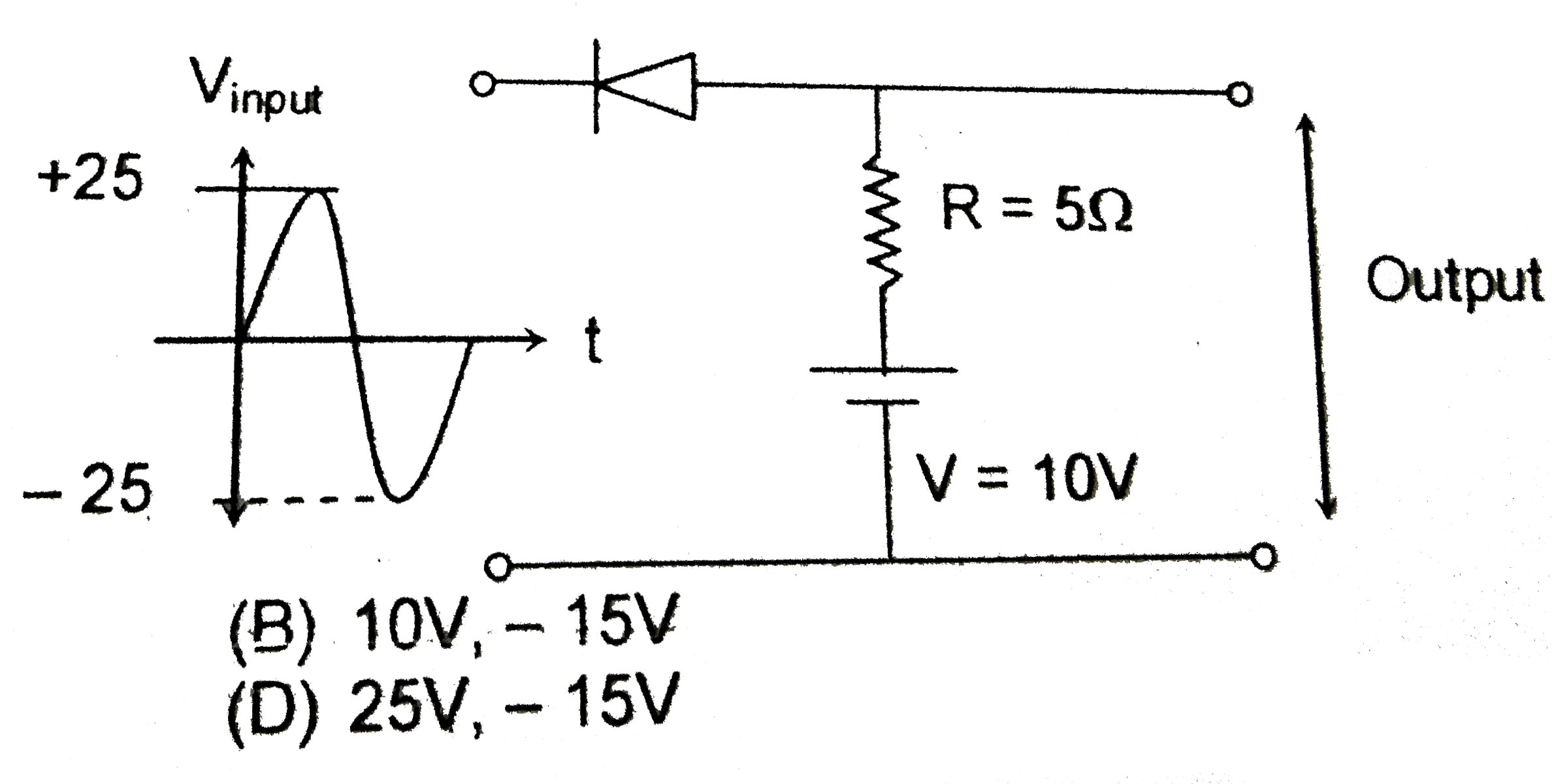A fullwave P.N diode rectifier used load resistor of 1500Ω. No filter is used. Assume each diode to have idealized characteristic with Rf=10Ω and Rr=ac. Since wave voltage applied to each diode has amplitude of 30 volts and frequency 50 Hz. Calculate.
(i) Peak, d.c rms load current
(ii) d.c power output
(iii) A.C power input
(iv) Rectifier efficiency.
Let's solve the problem step by step.
Given Data:
- Load resistance, RL=1500Ω
- Forward resistance of each diode, Rf=10Ω
- Amplitude of the applied voltage, Vm=30V
- Frequency, f=50Hz
(i) Peak and D.C. RMS Load Current
1. Calculate the Equivalent Resistance:
Req=Rf+RL=10Ω+1500Ω=1510Ω
2. Calculate the Peak Load Current (Im):
Im=VmReq=30V1510Ω≈0.01987A=19.87mA
3. Calculate the Average D.C. Current (Idc):
Idc=2Imπ=2×19.87mAπ≈12.66mA
4. Calculate the RMS Current (Irms):
Irms=Im√2=19.87mA√2≈14.05mA
(ii) D.C. Power Output
1. Calculate D.C. Power Output (Pdc):
Pdc=I2dc×RL=(12.66×10−3A)2×1500Ω≈240.41mW
(iii) A.C. Power Input
1. Calculate A.C. Power Input (Pac):
Pac=I2rms×Req=(14.05×10−3A)2×1510Ω≈295.96mW
(iv) Rectifier Efficiency
1. Calculate Rectifier Efficiency (η):
η=PdcPac×100=240.41mW295.96mW×100≈81.21%
Summary of Results:
- Peak Load Current (Im): 19.87mA
- D.C. Average Current (Idc): 12.66mA
- D.C. RMS Current (Irms): 14.05mA
- D.C. Power Output (Pdc): 240.41mW
- A.C. Power Input (Pac): 295.96mW
- Rectifier Efficiency (η): 81.21%
- Load resistance, RL=1500Ω
- Forward resistance of each diode, Rf=10Ω
- Amplitude of the applied voltage, Vm=30V
- Frequency, f=50Hz
Req=Rf+RL=10Ω+1500Ω=1510Ω
Im=VmReq=30V1510Ω≈0.01987A=19.87mA
Idc=2Imπ=2×19.87mAπ≈12.66mA
Irms=Im√2=19.87mA√2≈14.05mA
Pdc=I2dc×RL=(12.66×10−3A)2×1500Ω≈240.41mW
Pac=I2rms×Req=(14.05×10−3A)2×1510Ω≈295.96mW
η=PdcPac×100=240.41mW295.96mW×100≈81.21%
- Peak Load Current (Im): 19.87mA
- D.C. Average Current (Idc): 12.66mA
- D.C. RMS Current (Irms): 14.05mA
- D.C. Power Output (Pdc): 240.41mW
- A.C. Power Input (Pac): 295.96mW
- Rectifier Efficiency (η): 81.21%
Topper's Solved these Questions
- WAVES AND OSCILLATIONSBOOK - ALLENCHAPTER - WAVES AND OSCILLATIONSEXERCISE - Part-1(Exercise-01)
53 Videos
- WAVES AND OSCILLATIONSBOOK - ALLENCHAPTER - WAVES AND OSCILLATIONSEXERCISE - Part-1(Exercise-02)
19 Videos
- WAVES AND OSCILLATIONSBOOK - ALLENCHAPTER - WAVES AND OSCILLATIONSEXERCISE - Part-2(Example)
15 Videos
- SEMICONDUCTORSBOOK - ALLENCHAPTER - SEMICONDUCTORSEXERCISE - Part-3(Exercise-4)
51 Videos
Similar Questions
A sinusoidal voltage of amplitude 25 volts and frequency 50 Hz is applied to a half wave rectifier using PN diode. No filter is used and the load resistor is 1000Ω. The forward resistance Rf ideal diode is 10Ω. Calculate.
(i) Peak, average and rms values of load current
(ii) d.c power output
(ii) a.c power input
(iv) % Rectifier efficiency
(v) Ripple factor.
View SolutionThe halfwave rectifier supplies power to be 1kΩ. The input supply voltage is 220 V neglecting forward resistance of the diode, calculate
(i) Vdc
(ii) Iac and
(iii) Ripple voltage (rms value)
View Solution
Knowledge Check
In a full wave junction diode rectifier, the input a.c. has r.m.s. value of 20 V. The transformer used is a step up transformer having primary and secondary turns ratio 1: 2. Calculate the d.c. voltade in the recitified output.
A12 VB24 VC36 VD42 V
An R-L-C circuit containing a 52Ω resistor , a 230 mH inductor, and a 8.8μF capacitor is driven by an AC voltage source that has an amplitude of 150 V and frequency f = 80 Hz . How much average power is dissipated by this circuit?
View Solution
An ideal diode is connected in a circuit with resistance R=5Ω and V=10 volt as shown in figure maximum and minimum value of output voltage. When no load applied is (assume diode to be ideal)
View SolutionAn ideal diode is connected in a circuit with resistance R=50ΩandV=10V. If an AC input signal shown in the figure is given to the circuit, then the maximum and minimum value of output voltage (without load) is


View SolutionAn 8 H inductor, a 2 μF capacitor and a 100 Ω resistor are connected in series to an A.C. supply of 220 V and 50 Hz. Calculate :
(i) Impedance of the circuit.
(ii) Current flowing through the circuit.
(iii)Phase difference between the current and the supply voltage.
(iv) Average power consumed by the circuit.
View SolutionIn an RC series circuit the rms voltage of source is 200V and its frequency is 50 Hz, if R=100ΩandC=100π(μ)F, find
(a) impedance of the circuit.
(b) power factor angle,
(c ) power factor,
(d) current,
(e) maximum current
View SolutionAn N−P−N transistor is being used in CE mode for which the current transfer ratio is α=2526. The input resistance is 1000Ω and amplitude of A.C. input voltage is 10 mV. The amplitude of the amplified output collector current is
View SolutionFigure (A) and (B) show two resistors with resistances R1 and R2 connected in parallel and in series. The battery has a terminal voltage of e.

Suppose R1 and R2 are connected in parallel .
(a) Find the power delivered to each resistor.
(b) Show that the power used by each resistor is equal to the power supplied by the battery .
Suppose R1 and R2 are now connected in series
(c ) Find teh power delivered to each resistor.
(d) Show that the sum of the power by each resistor is equal to the power supplied by the battery.
(e ) Which configuration , parallelor series, uses more power ?
View Solution
